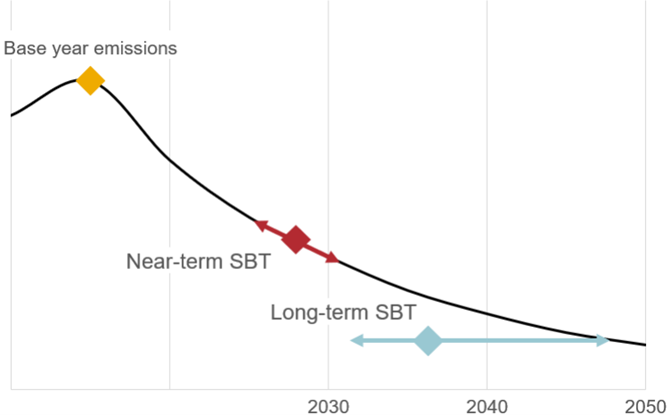Set Science-Based Targets
Environmental Defense Fund
When you set a science-based target, you are committing to an emissions reduction goal consistent with leading climate science. How you achieve this target will depend on identifying the most cost effective and feasible interventions for your company.

Target setting is an important step in your company’s sustainability journey. By setting emissions reduction targets, such as net zero by 2050, your company can hold itself accountable and track progress over time. Best practice is to align your company’s targets to the latest science and set science-based targets (SBTs).
Science-based targets are emissions reduction targets aligned to the latest climate science. As you set SBTs, your company must commit to near-term intermediary targets and a long-term target of reaching net zero by 2050. This will help keep planetary temperatures within 1.5-2°C of pre-industrial levels. That 2°C is important; even a small change in global average temperature has a significant effect on our planet. In fact, the Intergovernmental Panel on Climate Change (IPCC) has said that global warming must not exceed 1.5°C, or else we risk catastrophic impacts from climate change. Because of these risks, programs like the UN’s Race to Zero and organizations like the Science Based Targets Initiative (SBTi) have developed significant resources to help companies meet their SBTs.

Setting SBTs
To set an SBT you need to make several decisions that will help guide your target creation process:
- Type: Targets can be based on either an absolute reduction in emissions, such as a 50% reduction by 2030, or intensity. Intensity-based targets can be helpful if you have emissions from several different GHGs, because they can help you focus on those emissions from the highest intensity sources. Both absolute- and intensity-based targets should drive an absolute reduction in emissions over time, in alignment with science-based principles and reaching net zero by 2050.
- Scope: You also need to determine the scope of your targets. Is your company in a position to set targets against all Scopes 1, 2, and 3 emissions? While setting targets against all of your emissions is best practice, you may first need to build out the governance and processes to effectively track and abate Scope 3 emissions.
- Period: For each target, clarify whether it is a near-term or long-term target, and when you are expecting the company to meet it.
It can also be helpful to develop a roadmap. A roadmap can show your path from your base year emissions to meeting your SBT goals and net zero by 2050. One way to do this is to look at mitigation pathways. Mitigation pathways use GHG emissions projections to model the necessary reductions in emissions quantity and/or intensity to meet science-based goals.
Next Steps
After setting your SBTs, you need to identify ways to cut emissions to realize your goals. For example, you can focus on energy efficiency and low-carbon products to reduce your Scope 1 emissions and transitioning to renewable energy to reduce your Scope 2 emissions.
As you work to realize your SBTs, you may find that your investment needs have different risk–return profiles and greater uncertainty than other, more traditional investment types. It is important to conduct a financial assessment of specific interventions to determine the costs associated with achieving your targets and help prioritize actions with the greatest impact to cost ratio. It is also important to embed your SBTs into strategic planning and decision making, so that your company’s investments stay aligned to your targets and reduction pathway.